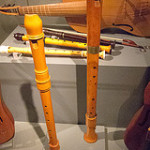 The recorder is the perfect instrument to introduce to students in 3rd or 4th grade. They are lightweight, simple to learn and fun to play. …..and teacher friendly ~ you can take off the mouth piece if a student insists on blowing inappropriately while allowing them to still practice their fingerings!! I have always enjoyed teaching it and am excited about having my students try out the new Aulos recorders in the fall. In researching this versatile instrument, I came across some facts that I thought might be helpful when introducing it to your students this year!
The recorder is the perfect instrument to introduce to students in 3rd or 4th grade. They are lightweight, simple to learn and fun to play. …..and teacher friendly ~ you can take off the mouth piece if a student insists on blowing inappropriately while allowing them to still practice their fingerings!! I have always enjoyed teaching it and am excited about having my students try out the new Aulos recorders in the fall. In researching this versatile instrument, I came across some facts that I thought might be helpful when introducing it to your students this year!
- In the mid-20th century, German composer and music educator Carl Orff popularized the recorder for use in schools as part of Orff-Schulwerk programs in German schools. (Ok, you might know this, but I thought it needed to be noted J)
- The recorder’s whistle mouthpiece is called a fipple or a duct
- King Henry VIII (r. 1509-47) owned 76 recorders that were likely played by the royal professional consort as well as by the King himself. (Reference)
- The recorder in the late sixteenth and seventeenth centuries was associated in opera and art with pastoral and erotic themes, however, Purcell and Handel included it in several vocal and stage works to symbolize lamination, death and the supernatural, in addition to the pastoral. (Reference)
- In the middle 1600’s, the recorder underwent a redesign that radically altered its capabilities:
- It was now divided into 3 sections, making it easier to tune
- It now had a range of 2 octaves,
- It created more brilliance and better reliability.
- It was done by Jean Hotteterre
- The physical presence of recorders in North America was documented as early as 1633 when an inventory of a plantation in New Hampshire listed 15 recorders, and a similar inventory taken at another New Hampshire property reported the presence of 26 recorders (Reference)
- Hunt (1977) notes that the first plastic recorders (cellulose acetate) were made in England early in World War II by Schott & Co, and sent to German-held prisoners-of-war, particularly those in the RAF, to help while-away the years of captivity (Reference)
- There are currently over 90 chapters of The American Recorder Society in existence throughout the U.S. and Canada.
- There is a WHOLE WEBSITE devoted to everything recorders. Check it out HERE! It shows up everywhere!
- …and just for fun…. How To Make A Recorder Out Of A Carrot!
References:
- The Metropolitan Museum Of Art
- The Recorder Society
- Wikipedia
- The Recorder Home Page
- The Golden Encyclopedia of Music by Norman Lloyd
